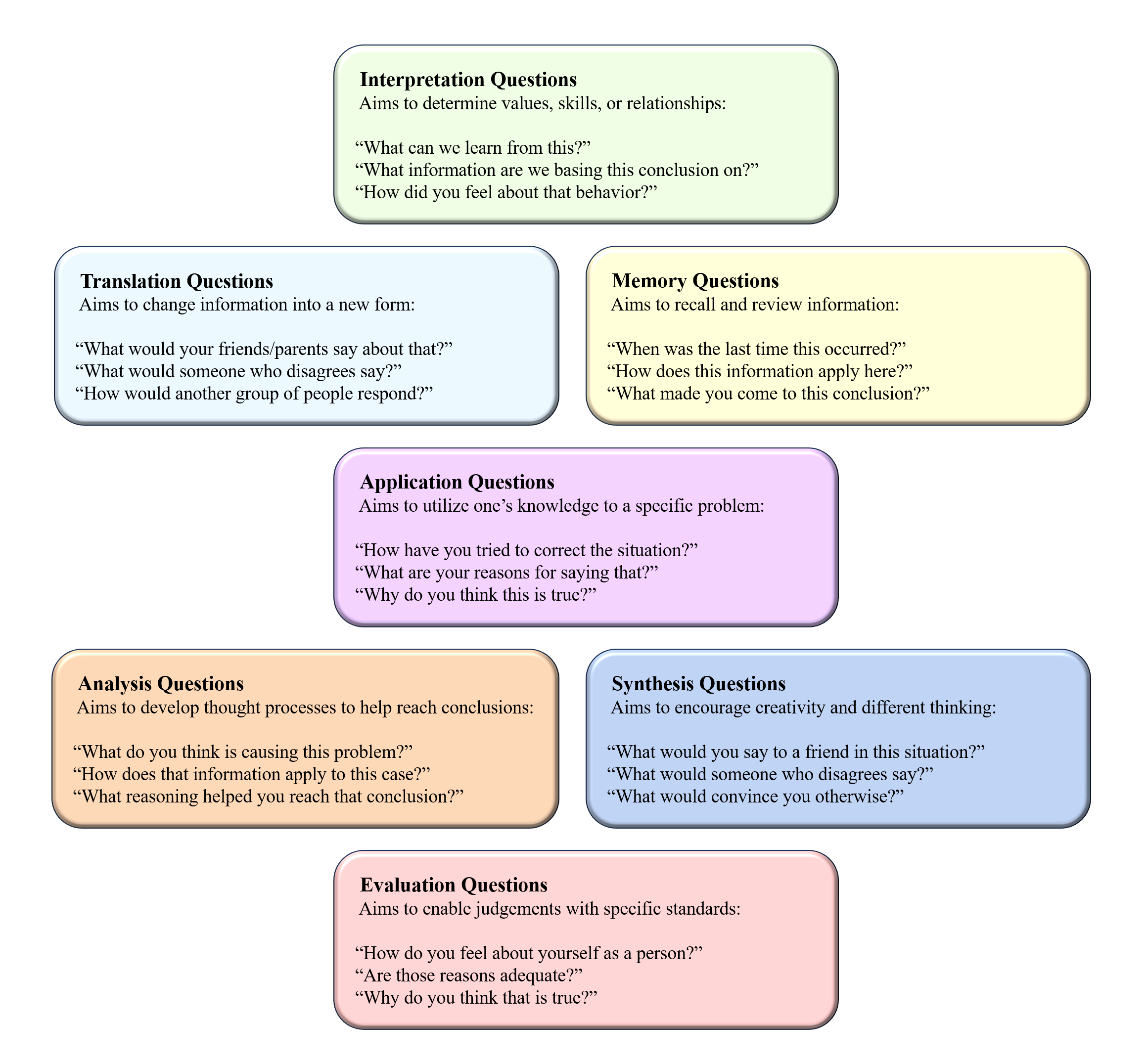Socratic Questioning
Overview
Socratic questioning (i.e., Socratic dialogue) includes the method of assisting clients in realizing new, less negative ways of thinking by helping them explore their own critical thinking and self-determination.[1,2] Mainly used in cognitive behavioral therapy (CBT), the aim is for the therapist and client to work as a team to guide the process of personal discovery, with no preconceived outcome or end goal in mind.[3]
Therapeutic Process
Socratic questioning follows two main steps. After informational questions have been asked to gather a basic understanding of the client’s current beliefs and attitudes, they are then invited to question those beliefs held.[4] The therapist then guides this questioning by asking different types of questions, such as memory, translation, synthesis, or application questions. The client is also encouraged to challenge any contradictions or misassumptions in their own reasoning. A main component of this question is that the client is held as the “expert of their own experience”, and the therapist is seen as “ignorant to the client’s experience”; thus the therapist takes on the role of listening and guides the client into finding methods that will help them assess their thoughts and improve their negative beliefs or attitudes.[5] The second phase encourages the client to think about alternative perspectives in hopes they can translate the guided discovery conducted with the therapist to their actual lives.[6]
The therapist’s backseat role is critical for Socratic questioning as it helps develop the client’s own form of critical thinking and will allow them to build their self-determination and flexible appraisal.[7] Guided discovery can include characteristics such as clarification of thought, exploration of the origin, examination of thought, or the examination of alternative viewpoints. These discussions must contain the sole purpose of exploration, and the therapist cannot hold any prior conclusions they would like to be met.[8] It is the hope that with the guidance of their therapist, the client can reach the appropriate conclusions on their own, and develop the skills to continue that critical thinking outside of sessions.[9]
Tips for Implementation
Some aspects essential to implementing Socratic questioning in a clinical setting may include:[10]
Incorporating the client’s previous knowledge
Asking questions in the client’s own language
Asking about alternative meanings or interpretations
Questioning any contradictions or inconsistencies
Types of Questions
The following graphic includes the various types of Socratic questioning that can be utilized in therapy, the aim of the questioning type and examples of each.[11]
Those interested in utilizing Socratic questioning to help overcome negative thinking patterns may reach out to a licensed therapist for additional guidance and support.
Contributed by: Ryann Thomson
Editor: Jennifer (Ghahari) Smith, Ph.D.
References
1 Carona, C., Handford, C. E., & Fonseca, A. (2020). Socratic questioning put into clinical practice. BJPsych Advances, 1–3. https://doi.org/10.1192/bja.2020.77
2 Vittorio, L., Murphy, S. T., Braun, J. D., & Strunk, D. R. (2022). Using Socratic Questioning to promote cognitive change and achieve depressive symptom reduction: Evidence of cognitive change as a mediator. Behaviour Research and Therapy, 150, 104035. https://doi.org/10.1016/j.brat.2022.104035
3 Socratic Dialogue | Center for Deployment Psychology. (n.d.). https://deploymentpsych.org/content/socratic-dialogue
4 Carona et al. (2020)
5 Socratic Dialogue
6 Carona et al. (2020)
7 Ibid.
8 Vittorio et al. (2022)
9 Carona et al. (2020)
10 Copland, L. (2014, July 30). Staff Perspective: CPT and the Use of Socratic Dialogue/Questioning | Center for Deployment Psychology. https://deploymentpsych.org/blog/staff-perspective-cpt-and-use-socratic-dialoguequestioning
11 Carona et al. (2020)

